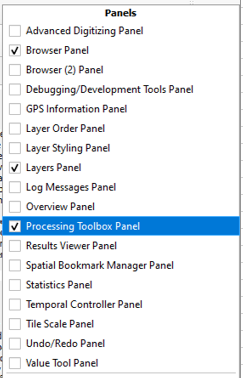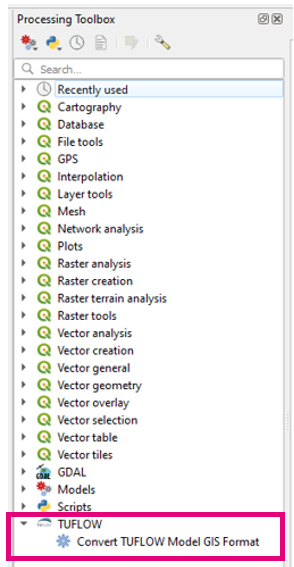Difference between revisions of "Convert TUFLOW Model GIS Format"
Ellis Symons (talk | contribs) |
Ellis Symons (talk | contribs) |
||
| Line 9: | Line 9: | ||
'''Parameters'''<Br> | '''Parameters'''<Br> | ||
| − | ''TCF''<Br> | + | ''<B>TCF</b>''<Br> |
Location of an existing TUFLOW model TCF file. This is the TCF of the model that will be converted.<br> | Location of an existing TUFLOW model TCF file. This is the TCF of the model that will be converted.<br> | ||
| − | ''Output Vector Format''<br> | + | ''<b>Output Vector Format</b>''<br> |
Output vector format of the converted model. Supported formats are ''GPKG, SHP, MIF''.<br> | Output vector format of the converted model. Supported formats are ''GPKG, SHP, MIF''.<br> | ||
| − | ''Output Raster Format''<Br> | + | ''<b>Output Raster Format</b>''<Br> |
Output raster format of the converted model. Supported formats are ''GTIFF, GPKG, ASC, FLT''.<Br> | Output raster format of the converted model. Supported formats are ''GTIFF, GPKG, ASC, FLT''.<Br> | ||
| − | ''Output Profile''<Br> | + | ''<b>Output Profile</b>''<Br> |
Input is use only for GPKG format outputs. GPKG is a database and can store multiple layers inside one file. This option determines how the output GPKG layers will be grouped into databases.<br> | Input is use only for GPKG format outputs. GPKG is a database and can store multiple layers inside one file. This option determines how the output GPKG layers will be grouped into databases.<br> | ||
| Line 34: | Line 34: | ||
Groups all layers together into one database.<br> | Groups all layers together into one database.<br> | ||
| − | ''Output Folder''<Br> | + | ''<B>Output Folder</b>''<Br> |
Optional parameter specifying the output location of the converted model. By default the output location will a new folder with the same name as the input TCF located in the same folder as the input TCF.<Br> | Optional parameter specifying the output location of the converted model. By default the output location will a new folder with the same name as the input TCF located in the same folder as the input TCF.<Br> | ||
| − | ''Root Folder''<br> | + | ''<b>Root Folder</b>''<br> |
By default the tool will try and find the 'root' folder containing the model files (commonly this folder is named 'TUFLOW'). The tool will try and guess the root folder based on the location of the TCF and the directory structure. If it can't find the root folder, or it picks the wrong folder then this parameter can be used to override this location within the tool. | By default the tool will try and find the 'root' folder containing the model files (commonly this folder is named 'TUFLOW'). The tool will try and guess the root folder based on the location of the TCF and the directory structure. If it can't find the root folder, or it picks the wrong folder then this parameter can be used to override this location within the tool. | ||
Revision as of 22:49, 8 April 2022
This tool will convert a TUFLOW model's GIS format (vector and raster layers) into a user specified, TUFLOW Supported, format. It works very similarly to the package model functionality that exists in TUFLOW and will try and package files from all scenarios/events. The difference between the package model functionality and this tool is that this tool will perform additional format conversion steps and update relevant control files to reflect these conversions.
- Available since TUFLOW Plugin v3.3
Running the Tool
This tool can be found in the QGIS processing toolbox panel under 'TUFLOW'. To open the Processing Toolbox Panel, navigate to 'View' in the menubar and select Panels >> Processing Toolbox Panel.
Parameters
TCF
Location of an existing TUFLOW model TCF file. This is the TCF of the model that will be converted.
Output Vector Format
Output vector format of the converted model. Supported formats are GPKG, SHP, MIF.
Output Raster Format
Output raster format of the converted model. Supported formats are GTIFF, GPKG, ASC, FLT.
Output Profile
Input is use only for GPKG format outputs. GPKG is a database and can store multiple layers inside one file. This option determines how the output GPKG layers will be grouped into databases.
Options:
- SEPARATE
This option will write each GPKG layer into its own database. Where the tool encounters commands that have multiple geometry types read in on the same line (using the vertical line delimiter "|"), the layers will be combined into a single database.
- GROUP BY CONTROL FILE 1
This option will group layers into databases defined by the control file they were specified in. In this option, TRD and TEF files are not considered separate control files.
- GROUP BY CONTROL FILE 2
Similar to "GROUP BY CONTROL FILE 1" except will treat TRD and TEF as separate control files.
- ALL IN ONE
Groups all layers together into one database.
Output Folder
Optional parameter specifying the output location of the converted model. By default the output location will a new folder with the same name as the input TCF located in the same folder as the input TCF.
Root Folder
By default the tool will try and find the 'root' folder containing the model files (commonly this folder is named 'TUFLOW'). The tool will try and guess the root folder based on the location of the TCF and the directory structure. If it can't find the root folder, or it picks the wrong folder then this parameter can be used to override this location within the tool.

